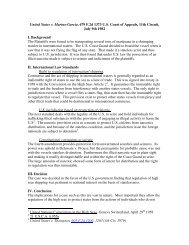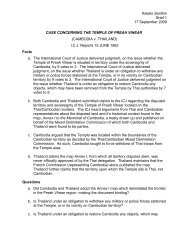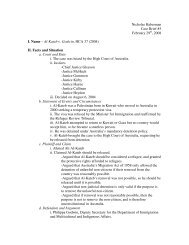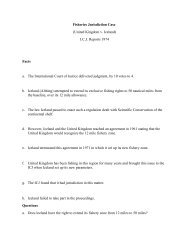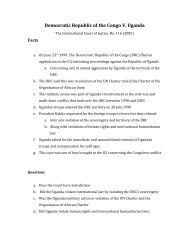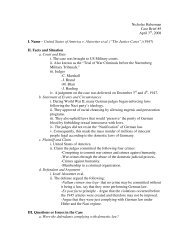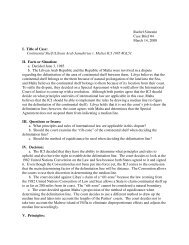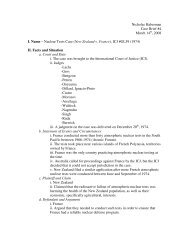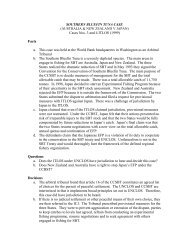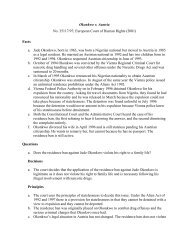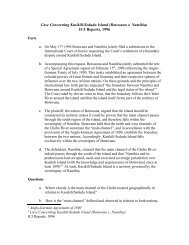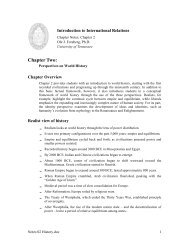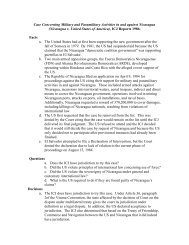Paul and Audrey Edwards v - Courses
Paul and Audrey Edwards v - Courses
Paul and Audrey Edwards v - Courses
You also want an ePaper? Increase the reach of your titles
YUMPU automatically turns print PDFs into web optimized ePapers that Google loves.
<strong>Paul</strong> <strong>and</strong> <strong>Audrey</strong> <strong>Edwards</strong> v. the United Kingdom<br />
ECHR (Application no. 46477/99) 2002<br />
Facts<br />
a. In December 1998 <strong>Paul</strong> <strong>and</strong> <strong>Audrey</strong> <strong>Edwards</strong> lodged a formal complaint in the<br />
European Court of Human Rights following a private, non-statutory inquiry<br />
commissioned six months earlier, in June 1998. The case was declared admissible<br />
on June 7 th , 2001, <strong>and</strong> a ruling was made by a chamber of seven judges.<br />
b. This case concerns the 1994 murder of Christopher <strong>Edwards</strong>, a thirty-year-old<br />
schizophrenic inmate of Chelmsford Prison, by his mentally ill cellmate, Richard<br />
Linford . In July 1995 <strong>Paul</strong> <strong>and</strong> <strong>Audrey</strong> <strong>Edwards</strong> commissioned a private nonstatutory<br />
investigation of their son’s death to examine the nature of the situation<br />
<strong>and</strong> the alleged failure of the state <strong>and</strong> the prison in protecting the human rights of<br />
their son. The Inquiry of Care <strong>and</strong> Treatment concluded that ideally Christopher<br />
<strong>Edwards</strong> <strong>and</strong> Richard Linford should not have been in prison <strong>and</strong> in practice they<br />
should not have been sharing a cell. 1 Furthermore, despite the “systematic<br />
collapse of protective mechanisms”, no civil remedies existed to uphold the<br />
finding that such “shortcomings…poor record keeping, inadequate<br />
communication, <strong>and</strong> limited inter-agency cooperation” were sufficient enough<br />
evidence to continue with criminal charges. 2 Although Linford was convicted of<br />
manslaughter by reason of diminished responsibility, negligence had occurred<br />
under the Fatal Accidents Act, when the prison guard failed to cite, report, or fix<br />
the broken emergency buzzer he had witnessed during the elapsed time of<br />
<strong>Edwards</strong>’ murder. The subsequent decision of the ECHR superceded the findings<br />
of the Crown Prosecution Service’s inquiry, <strong>and</strong> ruled that <strong>Edwards</strong>’ right to life,<br />
effective remedy, <strong>and</strong> investigation had been violated according to the European<br />
Convention on Human Rights, <strong>and</strong> awarded the applicants 20,000 British Pounds<br />
for legal costs <strong>and</strong> non-pecuniary damages.<br />
c. British citizens <strong>Paul</strong> <strong>and</strong> <strong>Audrey</strong> <strong>Edwards</strong>, Christopher’s parents, are the plaintiffs<br />
in this case. They privately commissioned the Inquiry of Care <strong>and</strong> Treatment <strong>and</strong><br />
lodged the subsequent complaint within the ECHR<br />
d. The defendant in this case is the state of the United Kingdom, against which <strong>Paul</strong><br />
<strong>and</strong> <strong>Audrey</strong> <strong>Edwards</strong> filed suit, regarding the incarceration <strong>and</strong> murder of their<br />
deceased son, Christopher.<br />
Questions<br />
a. Can the police officers who initially arrested <strong>and</strong> detained <strong>Edwards</strong> be held<br />
criminally responsible for electing not to complete a CID2 form <strong>and</strong> failing to<br />
1<br />
<strong>Paul</strong> <strong>and</strong> <strong>Audrey</strong> <strong>Edwards</strong> v. the United Kingdom, ECHR 2002<br />
2<br />
<strong>Paul</strong> <strong>and</strong> <strong>Audrey</strong> <strong>Edwards</strong> v. the United Kingdom, ECHR 2002
identifying <strong>Edwards</strong> as “an exceptional risk on the grounds of mental illness”, as<br />
expressed by the social worker<br />
b. Should Christopher have been rem<strong>and</strong>ed from police detention, on the grounds on<br />
his mental illness, when his parents [the applicants] met with the duty solicitor<br />
<strong>and</strong> explained the mental imbalance of their son, which required close medical<br />
attention<br />
c. Did the prosecutor violate <strong>Edwards</strong>’ rights by not rem<strong>and</strong>ing him to an<br />
appropriate medical facility for attention, in light of the fact that he had, at this<br />
point, been deemed a “perceived risk to women”, <strong>and</strong> the complete report of the<br />
psychiatrist had not yet been filed<br />
d. Was it a further violation of <strong>Edwards</strong>’ rights, that, [in light of the identification of<br />
Richard Linford as “sane but dangerous”, failure to file a CID2 form, or officially<br />
note his psychological state <strong>and</strong> previous convictions], he was forced to share a<br />
cell with Linford due to the prison’s “shortage of space”<br />
e. Did the officer, who failed to report or fix the broken emergency buzzer outside<br />
of the cell, violate <strong>Edwards</strong>’ right to protection <strong>and</strong> negligently allow his death to<br />
occur<br />
f. In light of the breaches of section 2 of the Mental Health Act of 1983, code C of<br />
the Police <strong>and</strong> Criminal Evidence Act of 1984, Prison Service Health Care<br />
St<strong>and</strong>ards [as established by the private Inquiry] were the applicants denied<br />
appropriate civil remedy by the Crown Protection Service, which claimed<br />
“insufficient evidence to proceed with criminal charges” 3<br />
Decision<br />
a. The ECHR ruled unanimously, on March 14 th , 2002, that regarding the death of<br />
Christopher <strong>Edwards</strong>, violations of Articles 2 (right of life, effective<br />
investigation) <strong>and</strong> 13 (right to effective remedy) of the European Convention of<br />
Human Rights had occurred. The Court held that, while Article 13 (civil act of<br />
negligence) had been breached as well, this avenue of redress was not applicable<br />
under the Human Rights Act of 1998 <strong>and</strong> that any continued breach of this<br />
obligation would be covered by Article 2. Under Article 41 (just satisfaction), of<br />
the Convention, the Court awarded the plaintiffs, <strong>Paul</strong> <strong>and</strong> <strong>Audrey</strong> <strong>Edwards</strong>,<br />
20,000 sterling pounds for non-pecuniary damages <strong>and</strong> legal costs.<br />
Principles<br />
a. The most critical points of this case rely on the fact that the authorities failed to<br />
protect the life of Christopher <strong>Edwards</strong>, which is evidenced by violations of the<br />
Human Rights Act of 1998 in domestic terms, <strong>and</strong> greater violations of<br />
3<br />
<strong>Paul</strong> <strong>and</strong> <strong>Audrey</strong> <strong>Edwards</strong> v. the United Kingdom, ECHR 2002
international law under the European Convention of Human Rights.<br />
b. Article 2 provides, “Everyone’s right to life shall be protected by law”.<br />
Whether or not the evidence had been filed, the authorities maintained inter alia<br />
awareness of “Richard Linford’s dangerous condition <strong>and</strong> Christopher <strong>Edwards</strong>’<br />
vulnerability” 4 . This right was thus violated by the failure of authorities to report<br />
findings, pass on information, reasonably place the men in separate facilities, <strong>and</strong><br />
repair the defective buzzer. As previously determined by Salman v. Turkey [GC],<br />
no. 21986/93, § 99, ECHR 2000-VII, “persons in custody are in a vulnerable<br />
position <strong>and</strong> that the authorities are under a duty to protect them. It is incumbent<br />
on the State to account for any injuries suffered in custody, which obligation is<br />
particularly stringent where that individual dies.” 5<br />
c. In any prison, the necessity for <strong>and</strong> purpose of an effective screening process is to<br />
identify prisoners who require “for their own welfare or the welfare of other<br />
prisoners to be placed under medical supervision”. 6<br />
d. Article 2 of the Convention also provides for the obligation of authorities, on<br />
behalf of the state, to carryout effective investigations. The court determined that<br />
“more rigorous scrutiny” 7 was necessary in this case to properly ensure<br />
“accountability for deaths occurring under potential state responsibility” 8 .<br />
e. Under Article 13 of the Convention, “Everyone whose rights are violated shall<br />
have an effective remedy before a national authority” 9 , <strong>and</strong> this case establishes<br />
that it is not enough for a government to offer remedies which may be available<br />
only in principle. Due to lack of sufficient evidence <strong>and</strong> witnesses, the prison<br />
authorities could not be held criminally responsible for their negligent actions,<br />
potentially contributing to the death of Christopher <strong>Edwards</strong>.<br />
Conclusion<br />
a. This case is important in the realm of International Law because it addresses<br />
several concerns relating to any individual’s [in accordance with the Convention]<br />
right to protection, effective investigation, <strong>and</strong> remedy, as essential human rights.<br />
Moreover, it underscores this right especially for vulnerable peoples, such as the<br />
mentally disturbed victim, Christopher <strong>Edwards</strong>, in the context of a prison. Under<br />
International Law, the Convention provides for all peoples’ rights to protection as<br />
well as the right to effective procedure including prompt <strong>and</strong> reliable means of<br />
effective investigation by able-bodied authorities. Furthermore, in the event that a<br />
potential victim may need to pursue a course of action, all persons maintain the<br />
right to effective remedy. This case establishes that such remedy must be effective<br />
4<br />
<strong>Paul</strong> <strong>and</strong> <strong>Audrey</strong> <strong>Edwards</strong> v. the United Kingdom, ECHR 2002<br />
5<br />
Salman v. Turkey, ECHR 2000<br />
6<br />
<strong>Paul</strong> <strong>and</strong> <strong>Audrey</strong> <strong>Edwards</strong> v. the United Kingdom, ECHR 2002<br />
7<br />
<strong>Paul</strong> <strong>and</strong> <strong>Audrey</strong> <strong>Edwards</strong> v. the United Kingdom, ECHR 2002<br />
8<br />
European Convention of Human Rights<br />
9<br />
European Convention of Human Rights
in practice, not just in principle, <strong>and</strong> must be a relevant <strong>and</strong> feasible avenue of<br />
redress. Above all, the State is bound by the Convention to uphold these<br />
provisions <strong>and</strong> ensure that all people are afforded these entitlements as essential<br />
Human Rights.<br />
Bibliography<br />
Salman v. Turkey [GC], no. 21986/93, § 99, ECHR 2000-VII<br />
<strong>Paul</strong> <strong>and</strong> <strong>Audrey</strong> <strong>Edwards</strong> v. the United Kingdom, ECHR (Application no. 46477/99)<br />
2002<br />
European Convention of Human Rights<br />
Submitted
Colleen Hill, November 19, 2009



